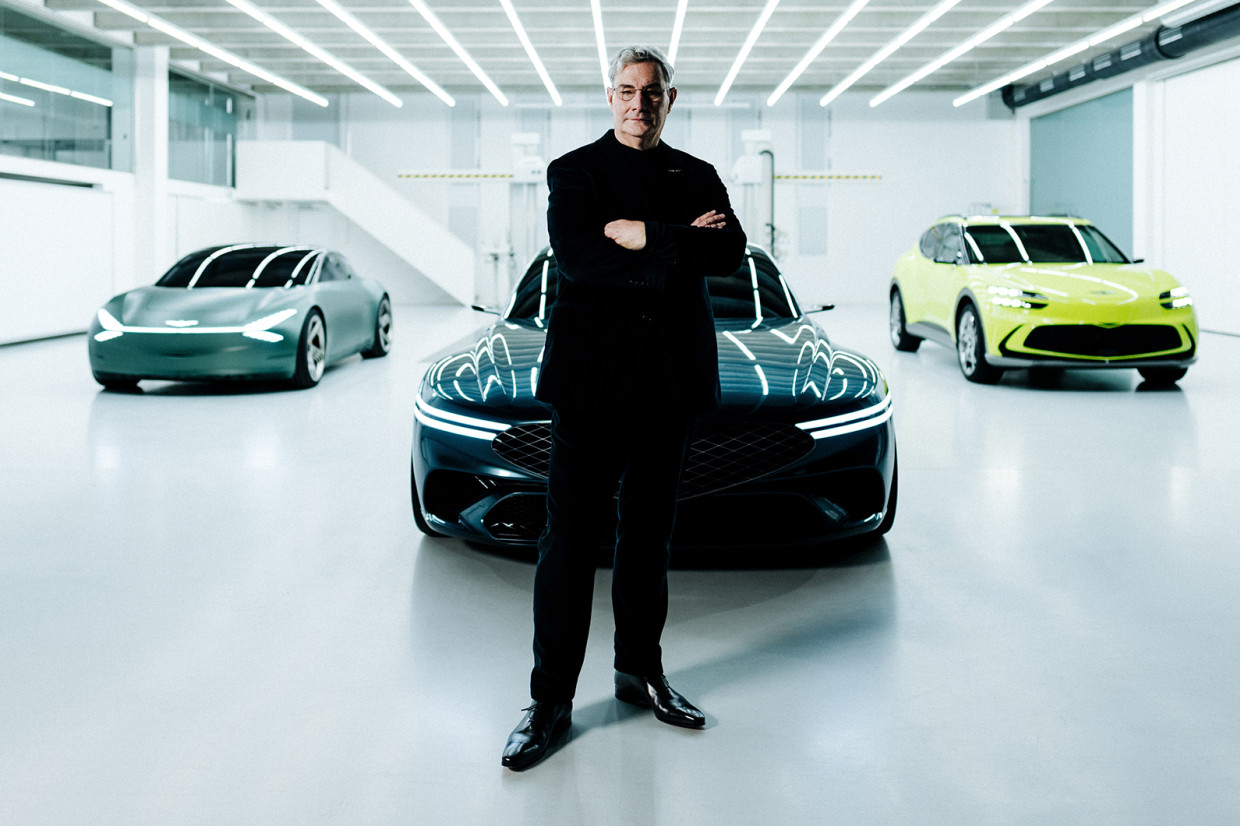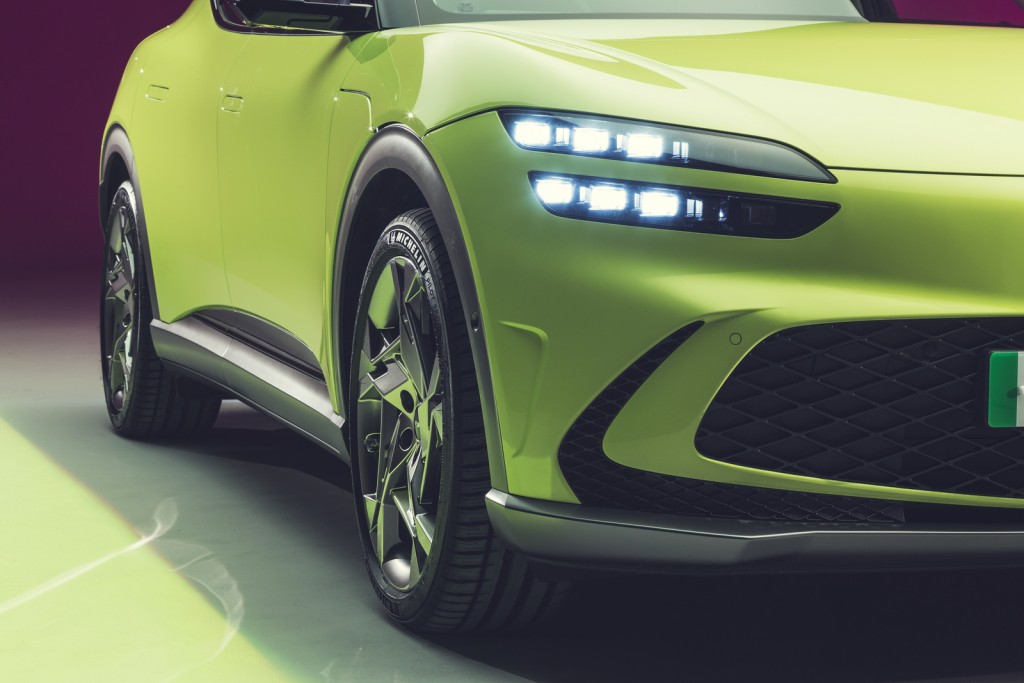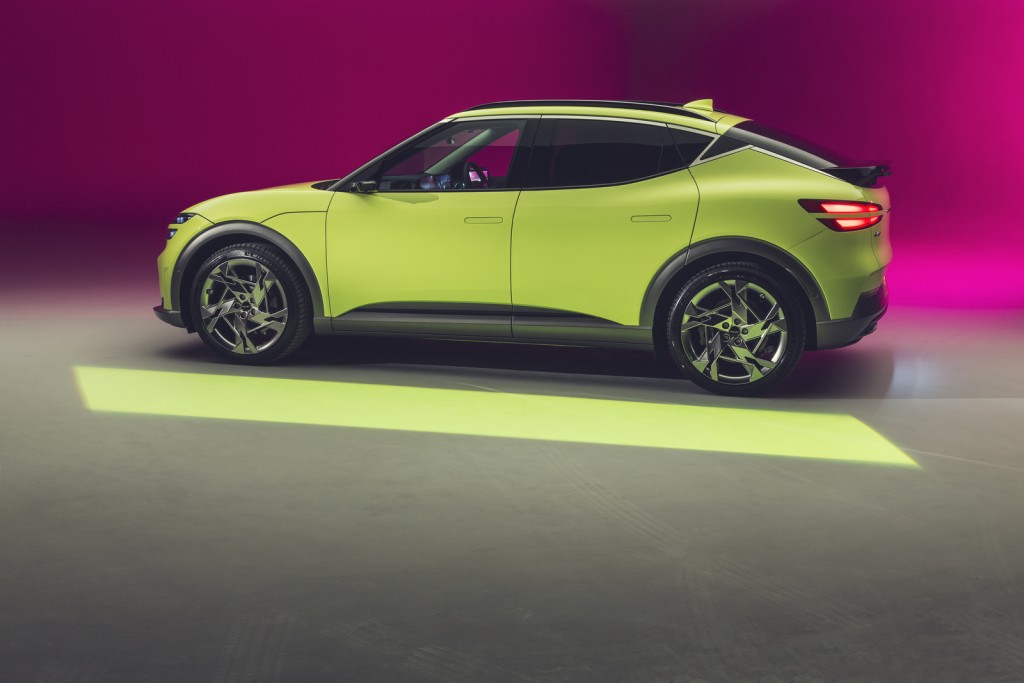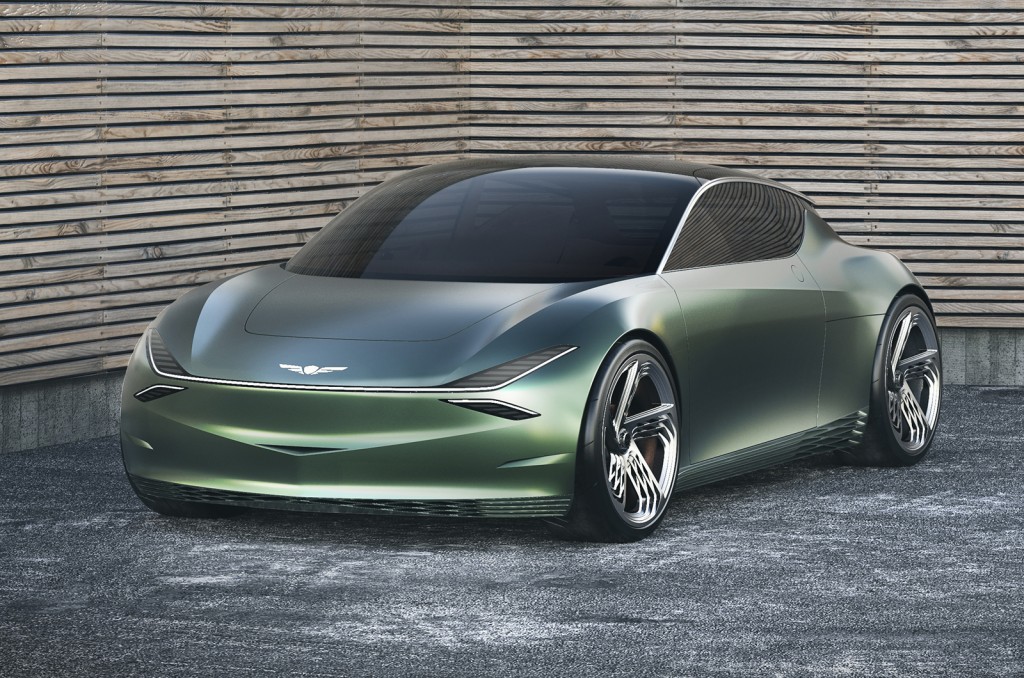
Genesis will follow up the recently launched GV60 crossover with seven further bespoke electric cars, as it pushes to establish itself as a standalone luxury brand.
The Hyundai Motor Group’s new premium marque launched in the UK and Europe last year with a handful of combustion-engined cars, such as the G70 saloon and GV70 SUV. But the firm is going all in on EVs in the future, with a planned range of eight cars built on the Hyundai Motor Group’s advanced E-GMP platform – which is also used for the Hyundai Ioniq 5 and Kia EV6.
The first of those bespoke EVs is the GV60, which Move Electric recently got the chance to take an in-depth look at. If you haven’t read our feature yet, we suggest you do so now. Don’t worry, we’ll wait.
Right, up to speed? Good. Because after seeing the GV60 we had a chance to catch up with Hyundai design guru Luc Donckerwolke, who currently serves as Genesis’s chief creative officer, to ask him about Genesis’s electric switch and the future potential of the brand.
The GV60 is just the start…
The GV60 won’t be the first electric Genesis: the firm has already launched the Electrified G80 which, as the name suggests, is an EV version of the big G80 saloon. But Donckerwolke says that the GV60 is “really important” for the brand.
Why? “It’s opening the next chapter for us: it’s the first car of a line-up of eight electric vehicles,” says Donckerwolke. “All the new launches you see from now on will be dedicated electric models. So this is the first car, the opening.”

Dinckerwolke wouldn’t get into what type of models would follow the GV60 next, but he suggested they would include models in new market segments for the firm and EVs that will effectively replace its current ICE cars when the latter reach the end of their production cycle.
That said, Donckerwolke warned against comparing new bespoke electric cars directly to ICE cars in terms of external dimensions. “Due to the [E-GMP] platform we will have generally longer wheelbases and more space inside the vehicle,” he says. “You will not be able to compare them one-to-one, because it’s a king of scale-up effect. Look at the GV60: it has the inside space of a car that’s bigger than it actually is. That will be the case for all future vehicles: the successor of the GV80 [large SUV] will be bigger inside.”
The development of the GV60
While Genesis is only a year old in Europe (it’s been around longer in the US and Korea), the GV60 already introduces a new ‘design language’ for the brand. That seems unusual, but Donckerwolke says it’s a key part of the strategy.
“It’s the first car following six years of intense work, in which we’ve basically created a whole new palette of cars with one design language,” he says. “It’s been quite the journey.”
That follows the decision to turn Genesis from a line of premium Hyundai models into a standalone brand. “That meant we would not be sharing any design language or any elements with Hyundai,” says Donckerwolke. “We really had to separate everything.
“It was really important to create something that was unique, because there is nothing worse than being the last ones to a party, and then you turn up wearing the same clothes as everyone else. We needed something that would be specific.”

Effectively, while Genesis launched with ICE cars, the brand was created in the age of electric vehicles. “The G90 [a large ICE saloon], which is basically the new flagship of the brand, closes the loop, so what is important now is to start tackling the new generation of cars, the second life of Genesis,” says Donckerwolke.
“When we started in 2016 we were lucky enough to know we would be working on electric vehicles. We didn’t design the DNA for the ICE cars and then go ‘oh now we have an issue’. From the beginning it was clear that we were doing a first generation of ICE vehicles - but we had to look further to the second.
“So the GV60 didn’t come unexpected to us. That’s why it’s in line with what we’ve done with the other cars in some areas, but a departure in other aspects. We’re starting to get more emotional as a brand, and that’s been considered from the very beginning.”
Why Genesis is skipping the hybrid step
While the GV60 introduces a new design language, there are strong links to the previous ICE models – and Donckerwolke says that’s because those machines were designed to build towards the future EV line-up.
Crucially, that’s also why the firm won’t offer plug-in hybrids as a ‘transition’ between ICE machines and EVs.
“It would have been worse is we’d done the Kodak or Nokia thing and tried to hold onto what we were doing, and said ‘okay, we’ll see later what we need for an EV design’,” he says. “From the very beginning we said ‘okay we know where we’re going, so we’re not going to do a transition phase with hybrids,’
“We are going directly from combustion engines to EVs, so it’s a clear cut with no transition phase where we’re trying to be like a Swiss Army knife, doing everything and probably not doing anything right.”
Why not start with an EV only line-up?
Given Genesis was created in an electric vehicle age, and will only launch new electric vehicle from now on, why did the firm bother launching combustion-engined cars at all?
“We never defined Genesis as an electric vehicle company,” says Donckerwolke. “ Obviously we are going through an electric expansion phase and we will be fully electric, but to wait and launch with a full line-up of electric vehicles would have meant postponing our entrance in the European market until 2026 or 2027. Launching as an EV-only brand in the current European market would have been a mistake: the market today is not ready for a full line-up of electric vehicles.”
The model naming strategy
Unusually, the GV60 bears no designation to show it’s a bespoke electric car. That puts Genesis apart from most other brands, which have introduced separate bespoke EV models lines (think Hyundai’s Ioniq or Volkswagen’s ID line-up).
Instead, the GV60 fits into the current Genesis line-up: G for saloons (with Shooting Brake as a suffix for extraterrestrial versions) and GV for SUVs, with the number indicating its size.

“For us this was a natural choice,” says Donckerwolke. “We didn’t want to have any electric denomination, because as some point you’d have to shut down the light on one of them. It would have been like Coca-Cola deciding to only sell Light products and not the original one. Then every product would have been called Light.
“For us it’s important that the powertrain, whether diesel, electric, gasoline, fuel cell or electric, is not the differentiator.”
The GV60 isn’t a halo model
The GV60 might be hugely important as the first bespoke electric Genesis, but Donckerwolke bats away suggestions it will serve as the flagship ‘halo’ model of the range.
“It would be really sad if I told you it was, because then my hope of having great cars in the future would be limited,” he laughs. “The GV60 is a great car, but we have much more in the pipeline coming. The GV60 is a taste of things to come, the first car in the game.”
What is the future?
While Donckerwolke wouldn’t be drawn on future models, he did give some hints. When asked if the GV60 was a production version of the Mint – a super-cute city car concept shown a few years back – he said: “No. The Mint is not out of the plans, but it’s not part of the main line-up that we have defined for the coming years because of pure volume and the demand of the markets. But I still believe something below the GV60 could be really interesting.”

While the demands off the European, US and Korean markets are all different, Donckerwolke said the firm wasn’t planning to offer region-specific models. “Generally we will have a global line-up. We might do a region-specific offering, but we tried that with the G70 Shooting Brake for Europe and it didn’t work, because the other markets wanted it as well!”
Given the importance of the US market, we can guess that a successor to the current GV80 large SUV is likely, and would use the same extended-wheelbase version of the E-GMP platform as the recent Hyundai Seven and Kia EV9 concepts.
Donckerwolke also wouldn’t rule out performance models, using the same technology as the forthcoming Hyundai Ioniq 5 N and Kia EV6 GT. “There is no reason to exclude that, because performance versions do not disappear with ICE vehicles,” he says. “A certain part of the emotion of driving a vehicle is gone with the engine sound and the characteristics of the power delivery of an EV, so wanting the attributed that show performance will be more in demand than ever.”
But expect future EVs to be different again
While the GV60 introduces a new design language, Donckerwolke insisted that the coming generation of electric Genesis models would “not be bigger or smaller clones, like nesting dolls. Each car will have its own personality.”

That will extend to the details on the vehicles too: for example, Donckerwolke is proud of the GV60’s rotating crystal sphere controller, but says that will change in other cars.
“The usage and concept will be similar, but it would be really boring if I used the same crystal sphere in every model. On Genesis models you won’t see the same design applied to different cars.”
READ MORE
e-CARS
The 10 electric cars with the longest range
e-BIKES
Desiknio Pinion C1.9 Classic e-bike review
Ride for a worthy cause: Big Issue eBikes launches in Bristol
e-MOTORBIKES
Triumph reveals first electric TE-1 motorbike
BMW CE 04 electric scooter review
e-SCOOTERS
Superpedestrian Link e-scooter: first ride
The new battery tech designed to make e-scooters more sustainable
e-WORLD
New Candela C-8 electric hydrofoil has first 'flight'
Awake Ravik S 22 aims to take electric surfboards to the extreme

